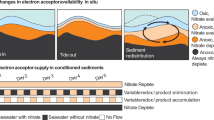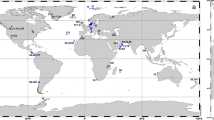Abstract
For decades, the conversion of organic nitrogen to dinitrogen gas by heterotrophic bacteria, termed heterotrophic denitrification, was assumed to be the main pathway of nitrogen loss in natural ecosystems. Recently, however, autotrophic bacteria have been shown to oxidize ammonium in the absence of oxygen, yielding dinitrogen gas. This process, termed anammox, accounts for over 50% of nitrogen loss in marine ecosystems1,2,3,4,5. However, the significance of anammox in freshwater ecosystems has remained uncertain6,7. Here, we report the occurrence of anammox hotspots at land–freshwater interfaces of lake riparian zones in North China, using molecular and isotopic tracing technologies. Laboratory incubations measuring anammox activity at substrate concentrations no more than 10% of those observed in situ yielded some of the highest potential activities reported for natural environments to date. Potential rates of anammox peaked in sediments sampled from the interface between land and water, as did the abundance of annamox bacteria. Scaling our findings up to the entire lake system, we estimate that interfacial anammox hotspots account for the loss of 103 g Nm−2 yr−1 from this lake region, and around one fifth of the nitrogen lost from the land–water interface.
This is a preview of subscription content, access via your institution
Access options
Subscribe to this journal
Receive 12 print issues and online access
$259.00 per year
only $21.58 per issue
Buy this article
- Purchase on Springer Link
- Instant access to full article PDF
Prices may be subject to local taxes which are calculated during checkout



Similar content being viewed by others
References
Kuypers, M. M. M. et al. Anaerobic ammonium oxidation by anammox bacteria in the Black Sea. Nature 422, 608–611 (2003).
Dalsgaard, T., Canfield, D. E., Petersen, J., Thamdrup, B. & Acuña-González, J. N2 production by the anammox reaction in the anoxic water column of Golfo Dulce, Costa Rica. Nature 422, 606–608 (2003).
Kuypers, M. M. M. et al. Massive nitrogen loss from the Benguela upwelling system through anaerobic ammonium oxidation. Proc. Natl Acad. Sci. USA 102, 6478–6483 (2005).
Arrigo, K. R. Marine microorganisms and global nutrient cycles. Nature 437, 349–355 (2005).
Lam, P. et al. Linking crenarchaeal and bacterial nitrification to anammox in the Black Sea. Proc. Natl Acad. Sci. USA 102, 6478–6483 (2007).
Zhu, G., Jetten, M. S. M., Kuschk, P., Ettwig, K. & Yin, C. Potential roles of anaerobic ammonia and methane oxidation in the nitrogen cycle of freshwater wetland ecosystems. Appl. Microbiol. Biotechnol. 86, 1043–1055 (2010).
Humbert, S. et al. Molecular detection of anammox bacteria in terrestrial ecosystems: Distribution and diversity. ISME J. 4, 450–454 (2010).
McClain, M. E. et al. Biogeochemical hot spots and hot moments at the interface of terrestrial and aquatic ecosystems. Ecosystems 6, 301–312 (2003).
Naiman, R. J. & Décamps, H. The ecology of interfaces: Riparian zones. Annu. Rev. Ecol. Syst. 28, 621–658 (1997).
Wang, Y. et al. Spatial distribution of archaeal and bacterial ammonia oxidizers in the littoral buffer zone of a nitrogen-rich lake. J. Environ. Sci. 24, 790–799 (2012).
Wang, W. D., Wang, D. L. & Yin, C. Q. A field study on the hydrochemistry of land/inland water ecotones with reed domination. Acta Hydroch. Hydrob. 30, 117–127 (2002).
Hefting, M. M., Bobbink, R. & Janssens, M. P. Spatial variation in denitrification and N(2)O emission in relation to nitrate removal efficiency in a n-stressed riparian buffer zone. Ecosystems 9, 550–563 (2006).
Zhu, G. et al. Anaerobic ammonia oxidation in a fertilized paddy soil. ISME J. 5, 1905–1912 (2011).
Meyer, R. L., Risgaard-Petersen, N. & Allen, D. E. Correlation between anammox activity and microscale distribution of nitrite in a subtropical mangrove sediment. Appl. Environ. Microbiol. 71, 6142–6149 (2005).
Trimmer, M., Nicholls, J. C., Morley, N., Davies, C. A. & Aldridge, J. Biphasic behavior of anammox regulated by nitrite and nitrate in an estuarine sediment. Appl. Environ. Microbiol. 71, 1923–1930 (2005).
Zhu, G. et al. Anammox bacterial abundance, biodiversity and activity in a constructed wetland. Environ. Sci. Technol. 45, 9951–9958 (2011).
Strous, M. et al. Missing lithotroph identified as new planctomycete. Nature 400, 446–449 (1999).
Verhamme, D. T., Prosser, J. I. & Nicol, G. W. Ammonia concentration determines differential growth of ammonia-oxidising archaea and bacteria in soil microcosms. ISME J. 5, 1067–1071 (2011).
Martens-Habbena, W., Berube, P. M., Urakawa, H., de la Torre, J. R. & Stahl, D. A. Ammonia oxidation kinetics determine niche separation of nitrifying archaea and bacteria. Nature 461, 976–979 (2009).
Teixeira, C., Magalhaes, C., Joye, S. B. & Bordalo, A. A. Potential rates and environmental controls of anaerobic ammonium oxidation in estuarine sediments. Aquat. Microb. Ecol. 66, 23–32 (2012).
Wang, W. & Yin, C. The boundary filtration effect of reed-dominated ecotones under water level fluctuations. Wetlands Ecol. Manage. 16, 65–76 (2008).
Kartal, B. et al. Molecular mechanism of anaerobic ammonium oxidation. Nature 479, 127–130 (2011).
Yin, C. & Lan, Z. The nutrient retention by ecotone wetlands and their modification for Baiyangdian Lake restoration. Wat. Sci. Technol. 32, 159–167 (1995).
Harhangi, H. R. et al. Hydrazine synthase, a unique phylomarker to study the presence and biodiversity of anammox bacteria. Appl. Environ. Microbiol. 78, 752–758 (2012).
Wang, Y. et al. Co-occurrence and distribution of nitrite-dependent anaerobic ammonium and methane-oxidizing bacteria in a paddy soil. FEMS Microbiol. Lett. 336, 79–88 (2012).
Risgaard-Petersen, N., Nielsen, L. P., Rysgaard, S., Dalsgaard, T. & Meyer, R. L. Application of the isotope pairing technique in sediments where anammox and denitrification co-exists. Limnol. Oceanogr. Meth. 1, 63–73 (2003).
Thamdrup, B. & Dalsgaard, T. Production of N2 through anaerobic ammonium oxidation coupled to nitrate reduction in marine sediments. Appl. Environ. Microbiol. 68, 1312–1318 (2002).
Wang, H., Yang, L., Wang, W., Lu, J. & Yin, C. Nitrous oxide (N2O) fluxes and their relationships with water-sediment characteristics in a hyper-eutrophic shallow lake, China. J. Geophys. Res. 112, G01005 (2007).
Kurola, J., Salkinoja-Salonen, M., Aarnio, T., Hultman, J. & Romantschuk, M. Activity, diversity and population size of ammonia-oxidising bacteria in oilcontaminated landfarming soil. FEMS Microbiol. Lett. 250, 33–38 (2005).
Acknowledgements
The authors would like to thank M. Yang, J. He, Y. Mu and J. Liu for their help, and J. Guo and B. Qu for discussions. This research is financially supported by the National Natural Science Foundation of China (No. 21077119), Knowledge Innovation Program of the Chinese Academy of Sciences (KZCX2-EW-410-01), and special fund of State Key Joint Laboratory of Environment Simulation and Pollution Control (12L03ESPC). Moreover, G.Z. gratefully acknowledges the support of the Beijing Nova Program (2011095) and K.C. Wong Education Foundation, Hong Kong. The anammox research of Mike Jetten is supported by ERC Advanced Grant 232937 and the 2012 Spinoza Prize of the Netherlands Organization for Scientific Research (NWO). N.R-P. is funded by the German Max Planck Society and the Danish National Research Foundation.
Author information
Authors and Affiliations
Contributions
The project was conceived and led by G.Z. and C.Y. S.W., W.W., Y.W., L.Z., B.J. and G.Z. contributed to the sample analysis. G.Z. wrote the paper and all co-authors substantially contributed by commenting upon and revising it.
Corresponding author
Ethics declarations
Competing interests
The authors declare no competing financial interests.
Supplementary information
Supplementary Information
Supplementary Information (PDF 2042 kb)
Rights and permissions
About this article
Cite this article
Zhu, G., Wang, S., Wang, W. et al. Hotspots of anaerobic ammonium oxidation at land–freshwater interfaces. Nature Geosci 6, 103–107 (2013). https://doi.org/10.1038/ngeo1683
Received:
Accepted:
Published:
Issue Date:
DOI: https://doi.org/10.1038/ngeo1683



